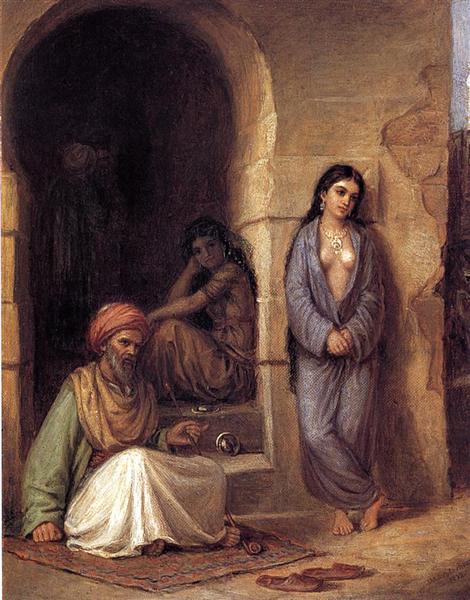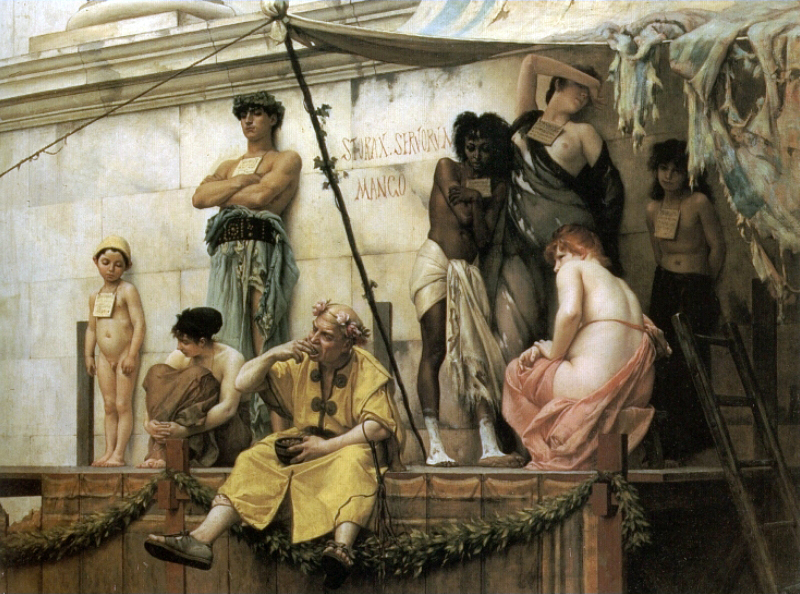Since ancient times that we can find representations of slavery in European art. Even though most of people think that only existed black slaves or from Africa, and it is true that they’re the great majority, in art we can find depictions of slaves of very different ethnicity and origins.

A Turkish slave by Parmigianino, 1533 
Afrique or Why be born a slave? by Jean-Baptiste Carpeaux, 1868-70 
Odalisque bleue ou l’esclave blanche by Henri Matisse, 1922 
The Greek slave by James McNeill Whistler, 1885-86 
The slave by J. W. Waterhouse, 1872 
The white slave by Jean Lecomte de Nouÿ, 1888
In Europe the association of slavery and blackness increased from 17th century onwards. Nonetheless, before this period, the slaves were predominantly white. So, we must not confuse “blacks” in art with “slaves” in art; since slaves were not always black and vice versa. In this article I will focus on the examples found in European art, since the vast majority of the examples I have found are from European artists, but I intend to address this theme again later and offer other perspectives.
In Art
Since the Renaissance is possible to find depictions of slavery. Most of the times they are figures in chains, crouching and very often naked, or almost naked. This kind of images have its roots in the Roman Triumph, but enslavement increased in Europe with the colonies many countries had, especially, in America and Africa. It was very common among the artists to use their kitchen slaves as models for muscular nude bodies.
Two of the first Dutch painters to portray slavery were Frans Post and Albert Eckhout (who depicts the ethnic mix in Dutch Brazil), they painted slaves working in idyllic rural landscapes, which had nothing to do with the harshness of their lives.

Mameluca by Albert Eckhout – National Museum of Denmark 
Tupian woman with baby by Albert Eckhout
During the 19th century, many European artists specialised in Oriental subjects, most of these works were produced during their travels in Western Asia, as in that time artists and scholars were described as Orientalist, especially in France where the term was popular by the art of Jules-Antoine Castagnary or Jean-Léon Gérôme. The Orientalism was considered as an art movement with the formation of the French Orientalist Painters Society and it was one of the branches of 19th century academic art, even if many different styles of Orientalist art were evident.
In many portraits of noble families in Europe, even families of the high-class, show them in the company of black figures, especially children, whose status are advertised by the silver slave collar they’re wearing. Very often this silver collar is worn in conjunction with luxurious clothes and other finery, what allowed to show off the wealth of the owner. During 17th and 18th centuries, the fashion among wealthy European families was to have their black slaves and servants wear the silver collars, which were often inscribed with the name of the owner or the employer.

A Roman slave market by Jean-Léon Gérôme, 1884 
The slave market by Gustave Boulanger, 1882
Besides the slave collar there are other symbols or iconographic marks of enslavement in art as chains, fetters and manacles. The slaves were treated as chattel, so we should not be surprised if in some paintings we can see them branded like cattle. Other sign of enslavement we can see in art is the cropped pony tail (topknot) which is a mark of the Turkish enslaved in the galleys. With the Abolitionism the imagery of slavery was turned to a social/political purpose and the broken chain in a symbol of dis-enslavement.
Some Depictions:
The biological determinism notion of race and racial distinction emerged in European representations as part of the development of some countries’ entry into the institutional and psychological structures of the modern world. And according to Griselda Pollock, in Western art, black women represent a typical space in modern male culture that emerges as an Orientalist and African fantasy among the artists and their contemporary art historians.

Musée des Beaux-Arts de Strasbourg
In Jean-Marc Nattier’s Mademoiselle de Clermont at her bath attended by slaves, painted in 1773 we have the perfect example of standard representation of black women in European art. They are shown in their “expected” social roles as servants and as exotic complements to their white mistress.
The only depiction of women slaves I found made by a woman artist is the Portrait de Madeleine by Marie-Guillemine Benoist. In historical and art-historical literature, this portrait is quoted as a rare image because it shows a single black figure as the main focus of the artwork (as the Portrait of citizen Belley by Anne-Louis Girodet de Roussy-Trioson).
Benoist’s painting is also interpreted as a response to the early 19th century French racialism and treatment of women. In it, Benoist is making an analogy of women and slaves. The painting is interesting in its aesthetic presentation and historical context, but also for its potential for new and critical readings.

The focus of the painting is the black woman, she is alone instead of serving any white mistress, and this is new, the usual is to see a white woman posing as the main model of a painting. But the negress is indeed serving a white woman, even if we cannot see her in the painting, she is serving the painter, posing to the portrait. So, in the end, she is presented in her expected social role.
Curiosities:
- It is very difficult to know who was the slave model who posed for an artist, but sometimes their names are known, as it is the case of Juan de Pareja, he was one of the slaves of Spanish painter Velázquez, who trained Pareja as a painter and freed him in 1650. We only know about him, because the manumission’s document survived. As a free man, he got some recognition as a painter.
- Sometimes it’s not clear if the person depicted is a slave, a servant or a free person, an obvious example of this is The portrait of Juan Pareja by Velázquez, in it is impossible to know if he was or not still slave at the time of the painting.
References:
- Daily History
- BBC
- Real Histories
- Oxford Bibliographies
- WikiArt – for some images
- Wikipedia
- Wikimedia Commons for some images









1 thought on “Female slaves in Art”
Comments are closed.